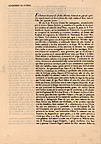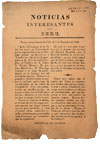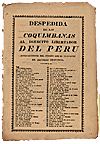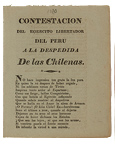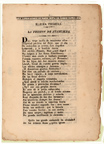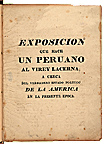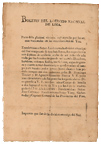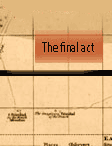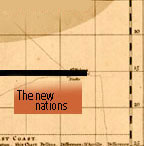| |
The Age of Spanish American Revolutions:
The Final Act
Facing mounting defeats, Spain sought to reinforce the Royalist armies in 1819-1820, preparing a force of 10,000 men. Marshalled in Cádiz for the voyage to the Americas, on 1 January 1820 Rafael Riego led a rebellion of the troops with the aim of restoring the Constitution of 1812. This ignited a civil war in Spain and by March of that year, the rebels were successful; with the royal palace surrounded, Fernando VII restored the constitution. These events not only deprived Royalist forces in Peru of reinforcements, but the reinstatement of the Constitution of 1812 prompted many defections to the Patriot cause. Moreover, it changed the political basis of the Royalist governments who saw, incorrectly, some conformity between the Patriots and the liberal Constitutionalists in Spain. San Martín formed a naval force and moved up the Peruvian coast, while Bolívar achieved the liberation of Venezuela following the Battle of Carabobo (24 June 1821). Quito (Ecuador) fell to the Patriots in May 1822 after a year-long struggle, and the decisive victory of Patriot forces at the Battle of Ayacucho (9 December 1824) ensured that independence could not be reversed although the remaining Royalist forces would not surrender Upper Peru (Bolivia) until 2 April 1825. |
|
|

War to the Death
Pablo Morillo, El teniente general D. Pablo Morillo, general en gefe del egército expedicionario de Costa-Firme, ha dado cuenta al Rey Nuestro Señor del siguiente suceso (Madrid: s.n, 1818).
|
|
|
George Dawson Flinter, A History of the Revolution of Carácas: Comprising an Impartial Narrative of the Atrocities Committed by the Contending Parties, Illustrating the Real State of the Contest, Both in a Commercial and Political Point of View. (London: Printed for T. & J. Allman, Princes Street, Hanover Square; Baldwin, Cradock, and Joy, Paternoster Row; and sold by Bell & Bradfute, Edinburgh; and W. Gribben, Dublin, 1819). |
|
|
James Hackett, Narrative of the Expedition Which Sailed from England in 1817. (London: [By W. Clowes for] J. Murray, 1818).
In 1813, Simón Bolívar issued the decree of War to the Death, under which creoles fighting for the Royalist cause would be spared, but peninsular Spaniards would be summarily executed. As Republican forces made advances in Venezuela, New Granada and elsewhere, this policy created much contemporary debate, and has contributed to Bolívar’s polemical legacy. Pablo Morillo, in command of the Spanish forces, penned this highly critical missive to the crown, and even British soldiers on the Royalist side (Flinter) and on the Republican side (Hackett) found cause to criticize the policy.
Acquired with the assistance of the JCB Associates fund and from the estate of Maury A. Bromsen |
|
| |
|
|
|
Praising Bolívar
Francisco de Paula Santander, El general Simon Bolivar en la campaña de la Nueva Granada de 1819 (Santafé [de Bogotá]: Imprenta del C.B.E. por el C. Nicomedes Lora, 1820).
During the campaign to liberate New Granada in 1819, Francisco de Paula Santander was elevated to the rank of General by Simón Bolívar. This pamphlet, issued anonymously, praises Bolívar and the conduct of this campaign. It is known to have been authored by Santander, however, since the first letter of paragraphs 2-18 spell “Santander su autor.”
Acquired with the assistance of a gift from Artemis Joukowsky and the Special Purchase Fund |
|
| |
|
|
|
Unassailable Callao
Noticias interesantes del Peru: Gaceta extraordinaria de Chile de 7 de setiembre de 1820 (Buenos Aires: Imprenta de los Expositos, 1820).
Republican forces aided by British naval ships began ascending the west coast of South America following their victory at Santiago. The fortified port city of Callao, in Royalist hands, was one of their central objectives. This broadside announces, incorrectly, that Republican forces under General Guemes had defeated Royalist troops under Ramirez, and the fall of Callao. The stronghold would, however, remain in Royalist hands until very late in the wars of independence.
Acquired from the estate of Maury A. Bromsen |
|
| |
|
|
| |
FROM THE SOUTH |
|
|
Grand farewell
Despedida de las Chilenas al egercito libertador del Perú (Santiago de Chile: s.n, 1820).
|
|
|
Despedida de las Coquimbanas al egercito libertador del Peru especialmente del cuerpo que se conpletó [sic] en aquella provincia (Santiago de Chile: s.n, 1820). |
|
|
Ejército Libertador del Perú, Contestacion del egercito libertador del Peru a la despedidad de las Chilenas (Santiago de Chile: s.n, 1820).
From the early viceregal period, crown and church officials were festively greeted with ephemeral allegorical arches, poetry contests and popular celebrations. These three verse “farewells” turn this tradition on its head, celebrating not the arrival of a viceroy, but a hoped-for expulsion of him by the departing troops. |
|
| |
|
|
|
Propaganda war
José de San Martín, Proclama a los habitantes del estado de Chile. (Santiago, Chile: s.n, 1820).
Provincias Unidas del Río de la Plata, Proclamas del general San Martín: a los habitantes del estado de Chile. (Buenos Aires: Imprenta de la Independencia, 1820).
Seeking to erode support for the Royalists in Peru, and to gain support for the Republican cause, San Martin issued numerous proclamations announcing his intentions for the campaign northward. The broadside on the left, issued in Santiago, was reissued in Buenos Aires (on the right), together with similar proclamations to the population of Rio de la Plata, the Peruvian nobility, peninsular Spaniards in Peru, and to the European and American soldiers. It concludes with the promise of another proclamation directed to “the fair sex of Peru,” to be published separately.
Acquired with the assistance of the JCB Associates |
|
| |
|
|
|
28 Points
José de la Riva-Aguero, Manifestación histórica y política de la revolucion de la América y mas especialmente de la parte que corresponde al Perú, y Rio de la Plata. (É impresa en Buenos Aires: Imprenta de los Expositos, 1818).
José de la Riva-Aguero was born in Lima of noble parents and educated in Spain. There he took part in the Spanish war of independence, fighting against Napoleon’s forces. He returned to Peru in 1809 and fought for independence on the Republican side. This work, also known as the “28 Causes” is credited with inciting a turn against the Royalist sentiment that had remained strong in Peru. |
|
| |
|
|
|
Figuerola Speaks
Justo Figuerola, Cartas a un amigo acerca del papel que se dice escrito en Lima, é impreso en Buenos Ayres, intilulado [sic] Manifestacion, histórica, y politica de la revolucion de la América, y mas especialmente de la parte que corresponde al Perú y Rio de la Plata. (Lima: Imprenta de Niños Expósitos, 1820).
Justo Figuerola, later to be one of the first to sign Peru’s declaration of independence, strongly criticized Riva-Aguero and penned this response in support of Royalist rule.
Gift of Michael Zinman |
|
| |
|
|
|
Inca nobility
Elegía primera: la prisión de Atahualpa (Bogotá?: s.n, 1821).
Atahualpa was the last Inca emperor, executed by Pizarro following a mock trial in 1533. In his Comentarios Reales de los Incas (1609), Garcilaso de la Vega points to Atahualpa as a victim of Spanish cruelty. Later creole elites, many of whom had indigenous ancestors, styled themselves as descendants of the indigenous nobility. The Comentarios Reales was banned in 1781 following the Tupac Amaru rebellion for fear that it might prompt indigenous claims to nobility, and to mute these arguments by the creoles. The author of this poem evokes Atahualpa in an appeal to Peruvian Royalists to embrace their Inca past and turn to the Republican cause.
Gift of J. Leon Helguera |
|
| |
|
|
|
Telling the viceroy “It’s over”
Exposicion que hace un peruano al virey Lacerna, acerca del verdadero estado politico de la America en la presente epoca (Santiago de Chile: Imprenta Nacional).
In a more prosaic vein, the anonymous author of this tract provides a clear statement, directed to viceroy Lacerna, that the Royalist cause in South America is lost. |
|
| |
|
|
|
Callao finally falls
Peru. Supremo Gobierno Provisional, El Supremo Gobierno Provisional Del Peru. Debiendo entregarse la plaza del Callao (Lima: s.n, 1821).
Republican forces laid siege to the heavily fortified Royalist stronghold of Callao in August 1821. The Republicans were heavily out-manned, however, and were unable to take the fortress, or to prevent an escape by the Royalist garrison. Nevertheless, on 19 September, General José de la Mer, in command of the Royalist forces, surrendered the small remaining garrison, and this broadside announces the three days of celebration that follow.
Acquired from the estate of Maury A. Bromsen |
|
| |
|
|
|
Welcome the liberators
Vicente Gago, Proclama del Dr. D. Vicente Gago, capellan del hospital militar de Santa Ana, a sus paisanos los habitantes de la provincia de Jauja, en su lengua nativa y peculiar (Lima: 1822: Imprenta de Rio, 1822).
As was the case at the outset of the campaigns in 1810, the Peruvian highlands and Upper Peru were Royalist strongholds. Here Vincent Gago appeals to residents of Jauja in both Spanish and Quechua to receive Republican forces and support the struggle, as Iturri Patiño had done in 1810.
Acquired with the assistance of the Harper fund |
|
| |
|
|
|
Temporary reversal
José de Canterac, Boletin del egercito nacional de Lima: Parte de la gloriosa victoria conseguida por las armas nacionales en las inmediaciones de Yca (Ica: Imprenta que fue de la division enemiga del Sur, 1822).
This broadside, announcing the temporary Royalist victory at Ica, was issued from a field press, proudly proclaiming that it had come from “The press that had belonged to the enemy division from the South.”
Acquired with the assistance of the Harper fund |
|
|
To next section: Forming the new nations |
|
